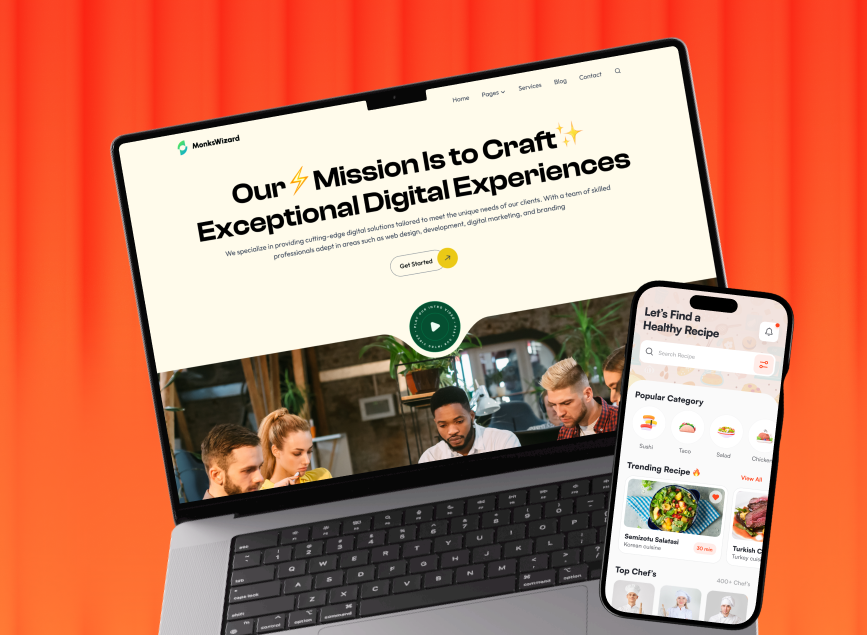
Key Takeaways
According to Linearity, a good UI can increase your website’s conversion rate by as much as 200%, while improved UX design can lead to conversion rates soaring to 400%. In the fitness industry, it’s almost impossible to create an engaging and user-friendly platform without utilizing UX design.
Good UX design ensures that fitness websites and apps are intuitive, accessible, and customized according to user needs. They result in higher engagement and retention. Simplified navigation helps users find what they need quickly, while mobile optimization ensures a seamless experience across different devices.
So, there’s no way we can deny the importance of UI and UX design in the fitness industry. Let’s check out the matter with more details and learn some best practices for using UX for the fitness industry.
Why UX Design Matters in the Fitness Industry?
The fitness industry is evolving at light speed. It is driven by technology and consumer expectations. Here, User Experience (UX) design plays a key role in making engaging, and user-friendly fitness solutions.

Here are some of the reasons why UX design matters in the fitness industry:
Improve User Engagement of the Fitness Website or App
UX design enhances user engagement by creating intuitive experiences. When fitness apps and websites are easy to navigate, users are more likely to stay engaged.
This type of increased engagement paves the way for better attachment to fitness programs. Also, it generates improved outcomes for users. Thus it facilitates higher retention rates for fitness businesses.
Help Personalize User Experiences
Personalization is essential in the fitness industry, and UX design enables the creation of tuned experiences. By grasping user preferences, behaviors, and goals, fitness platforms can provide customized workout plans.
Additionally, they can provide diet suggestions and progress tracking. This personalized approach motivates users and helps them achieve their fitness objectives.
Simplify Complex Information
Fitness involves a lot of complex information. They can be from workout routines to nutritional guidelines. Good UX design simplifies this information. They can make it accessible and understandable for users.
Clear visuals, straightforward language, and interactive elements help users realize important concepts. So, they can make informed decisions about their fitness journeys.
Encourage Consistent Usage
Consistency is fundamental for fitness success, and UX design encourages regular usage of fitness apps and platforms. Features like reminders, progress tracking, and rewards for milestones keep users motivated.
These functions all help them to stay committed to their fitness routines. An enjoyable user experience reduces the likelihood of users abandoning their fitness goals.
Build Trust and Credibility
A well-designed fitness app or website builds trust and credibility with users. Professional design, intuitive navigation, and reliable performance show users that they are using a trustworthy platform. This trust is essential for retaining users. Also, it will encourage them to recommend the platform to others.
Facilitate Community Building
UX design nurtures a sense of community among users. It is very important for motivation and support. Features like social sharing, group challenges, and forums entitle users to connect with others who share similar fitness goals.
This sense of community encourages accountability. So, it can make the fitness journey more enjoyable.
Support Accessibility and Inclusivity
Accessibility and inclusivity are picky considerations in UX design for startup fitness industry. Designing with diverse user needs in mind confirms that fitness platforms are usable by all kinds of people.
Moreover, inclusive design practices broaden the platform’s reach. Also, it demonstrates a commitment to serving all users.
UX design is necessary for the fitness industry. It can amplify user engagement, build trust, support accessibility, and much more. If you sort out UX design, your fitness businesses can make provocative solutions that meet the ever-changing user needs.
Digital Products in the Fitness Industry: With Good UX Vs. Without Good UX
You must understand why UX is mandatory for digital products like a website or app on fitness and health niches. Still, you may need to understand the difference a Good UX can bring to your product. The following table will give you a good idea of why you should prioritize UX matters on digital products of the fitness industry.

With good UX design, your fitness website’s navigation will be intuitive. The site will be mobile-optimized, visuals will be high-quality, and you can easily make it personalized based on the target audience.
All these facts matter in the long run. They all result in high user engagement, retention, trust, community building, and motivation. So, you can attract more audience which is a blessing for your business growth.
Best Practices for UX Design in the Fitness Industry
Creating an effective fitness website or app involves thoughtful design to amplify user experience and engagement. Here are eight design tips below to help you craft a compelling platform:
1. Use Minimal Navigation System
You should confirm that navigating your fitness website or app is straightforward. You can use clear menus, logical categorization of content, and notable calls to action.
It will guide many users through different sections. Also, you need to minimize the number of clicks required to access essential features like workout plans, progress tracking, and community forums.
2. Prioritize Responsiveness

As mobile usage is popular, you must optimize your fitness platform with all mobile app UX design practices. You should design responsive layouts that adapt to various screen sizes and orientations. Then you must emphasize essential features for mobile users.
Some of them are easy access to workouts, quick navigation, and efficient data input methods. Also, you have to test thoroughly across different devices to confirm a consistent experience.
3. Utilize Visual Elements and Videos
Visuals and videos are powerful tools for engaging users in fitness activities. You can use high-quality images of exercises, meal plans, and progress charts. They will inspire and educate users.
Additionally, you can add instructional videos that demonstrate proper form and technique. Those visual contents can amplify user perception and motivation exponentially. So, your visual content should be informative, appealing, and aligned with your brand’s aesthetic.
4. Try to Personalize User Experience
Personalization is prime to keeping users engaged and motivated. You must shape content based on user preferences, fitness goals, and past activities.
You can offer personalized workout recommendations, nutrition tips, and progress insights. Also, you can use data analytics to continuously refine and improve personalization algorithms. It will validate that your recommendations are relevant and effective.
5. Prioritize Accessibility
You must ensure that your fitness platform is accessible to users of all abilities. So, you have to design with accessibility standards in mind. Try to prioritize color contrast, font size, and screen reader compatibility considerations.
Moreover, you can provide alternative text for images and captions for videos. These will help users with visual impairments. Keep in mind that accessibility features can broaden your user base. As well as they can demonstrate inclusivity and empathy to all users.
6. Encourage Social Interaction
You can facilitate community building and social interaction within your fitness platform. For that, you have to add features like user profiles, activity feeds, and discussion forums. Here, users can share achievements, ask questions, and support each other.
You can enable the social sharing of workouts and progress updates. It will nurture motivation and accountability among users. If you can make an active community engagement, it will greatly amplify user satisfaction.
7. Provide Actionable Insights
You need to empower users with actionable insights into their fitness journey. So, you can display clear progress metrics, like workout frequency, calorie burn, and performance improvements. Also, you might want to use charts, graphs, and summaries to visualize data and highlight achievements.
You must remember that the insights should be easy to understand and actionable. These can really motivate users to set and achieve new fitness goals.
8. Continuously Iterate and Improve
Last but not least, you must regularly update and improve your fitness website or app. The improvements should be based on user feedback and analytics. Then, you can conduct usability tests, gather user insights, and prioritize feature enhancements. These will help you address user needs and pain points properly.
9. Try A/B Testing

Additionally, you can add A/B testing for design elements and functionality to identify improvements. These initiatives will elevate user experience and engagement. Finally, if you are consistent in iterating your sites and services, it will confirm that your platform remains relevant. Also, you will stay competitive in the ever-progressing fitness industry landscape.
10. Fast & Frictionless Onboarding
Make the first impression count by simplifying the signup process. Use social logins, skip unnecessary steps, and offer guided walkthroughs. A smooth start builds confidence, reduces drop-offs, and quickly gets users into the core experience.
Fitness Industry Graphic Design Solutions
Design isn’t just about looking good, it’s about making users feel good, too. In fitness apps and platforms, graphic design directly impacts motivation, clarity, and user engagement. Here's how great design supports better UX:
- Energetic Color Schemes: Bright, bold colors evoke energy and encourage users to take action.
- Clear Typography: Large, readable fonts help users navigate quickly, even during workouts.
- Motivational Imagery: Realistic, diverse visuals create connection and inspiration.
- Visual Hierarchy: Smart layout and spacing guide users to what matters most, whether it's a workout timer or a progress chart.
- Consistent Branding: Cohesive visuals build trust and make the experience feel professional and reliable
UX Challenges in Designing for the Fitness Industry
Designing for the fitness industry presents many unique challenges. As it holds a manifold of users with varying goals, it is essential to make an inclusive and engaging experience. So, let’s go through some of the key challenges and strategies to label them.

Creating a Clear Goal for User Diversity
Fitness users come with different objectives, like weight loss, muscle gain, or overall health. You should try to establish clear goals for mixed users. It will ensure everyone feels the same way in a positive way.
As a designer, you must create a primary setup process that marks user goals and personalizes their experience accordingly. This tuned approach can magnify user satisfaction and help them achieve their fitness milestones.
Making Suitable UI for Male and Female Users
Men and women often have different fitness goals and preferences. A suitable UI must house these differences without reinforcing stereotypes. So, you can use neutral design elements. Then you can add customization options that can help each type of user. For example, you can provide a range of workout plans and visual themes. They will ensure that all users find something that rings with them.
Designing Progression and Activity Trackers
Tracking progress in an active lifestyle is essential for motivation. So, designing effective progression and activity trackers calls for clear visual indicators and regular feedback.
As a designer, you should ensure that the users can easily see their achievements. They have to feel how close they are to their goals. Here, interactive elements like charts and progress bars can do the magic. Also, you can combine them with encouraging messages and notes. These little things will keep the users motivated and engaged.
Maintaining Consistency Because of Content Diversity
Fitness content is diverse and it includes workouts, nutrition tips, and wellness advice. If you can maintain a consistent design language across the varied content, it will confirm a cohesive user experience.
You must remember that consistent typography, color schemes, and navigation elements help users feel at home. Also, they can put some cream on the content they are exploring. This type of positive consistency builds trust and familiarity. Moreover, they can really amplify the user retention rate.
Encouraging Users for Long-term Engagement
Long-term engagement is fundamental for sustained fitness success. Gamification elements, like badges, challenges, and rewards, can encourage continued use.
Additionally, they can nurture a community through social features. Plus, real content from users can keep other users connected. Regular updates and new features also keep the experience fresh and exciting. Also, this approach reduces the risk of user drop-off.
So, fitness industry design works involve realizing user diversity, and many other major challenges. If you can go through these challenges, you can make riveting and supportive fitness experiences for all.
FAQs
What UX design elements are used in fitness apps?
Common UX design elements in fitness apps are user-friendly interfaces, personalized workout plans, progress tracking, social sharing features, motivational notifications, and integration with wearables. These elements help users stay engaged and motivated in their fitness journey.
How do data analytics work to optimize UX design in fitness apps?
Data analytics can be used to track user behavior, engagement patterns, and performance metrics. By analyzing this data, designers can identify trends, understand user needs, and make data-driven decisions to optimize UX design.
How can UX design improve accessibility in fitness products?
UX design can improve accessibility in fitness products by incorporating features like adjustable font sizes, voice commands, screen reader compatibility, and inclusive design practices.
What are the best practices for fitness app UI design?
The best practices for fitness app UI design is focusing on clarity, intuitive navigation, motivational visuals, and minimal clutter. You should also use progress tracking, bold CTAs, and responsive layouts to keep users engaged and help them achieve their fitness goals efficiently.
End Note
The industry doesn’t matter, UX is essential for any type of digital product. With a bad UX or literary no UX, your product won’t reach its aim and help you grow your business. For the fitness industry, it’s even more essential as users have the potential to visit the app or software consistently.
So, try to make it minimal, responsive, accessible, and visually nice while improving it in an iteration process. Focus on the user goals and do research beforehand. Best wishes for you.

.svg)






.png)
.png)
.avif)
.png)


.png)
.png)
.png)
.png)



.avif)



